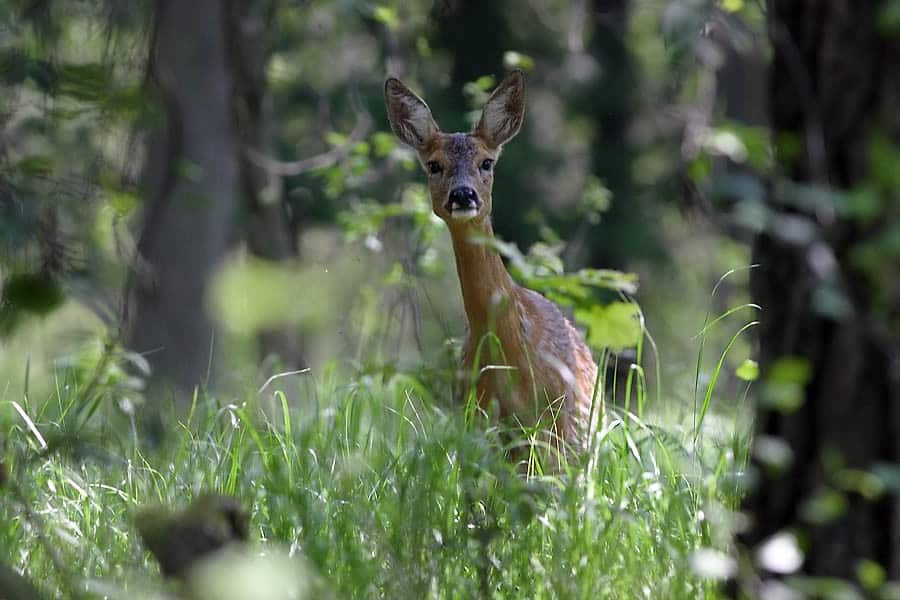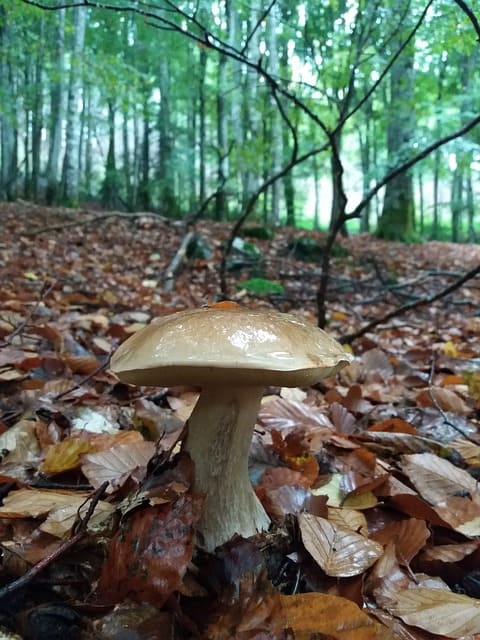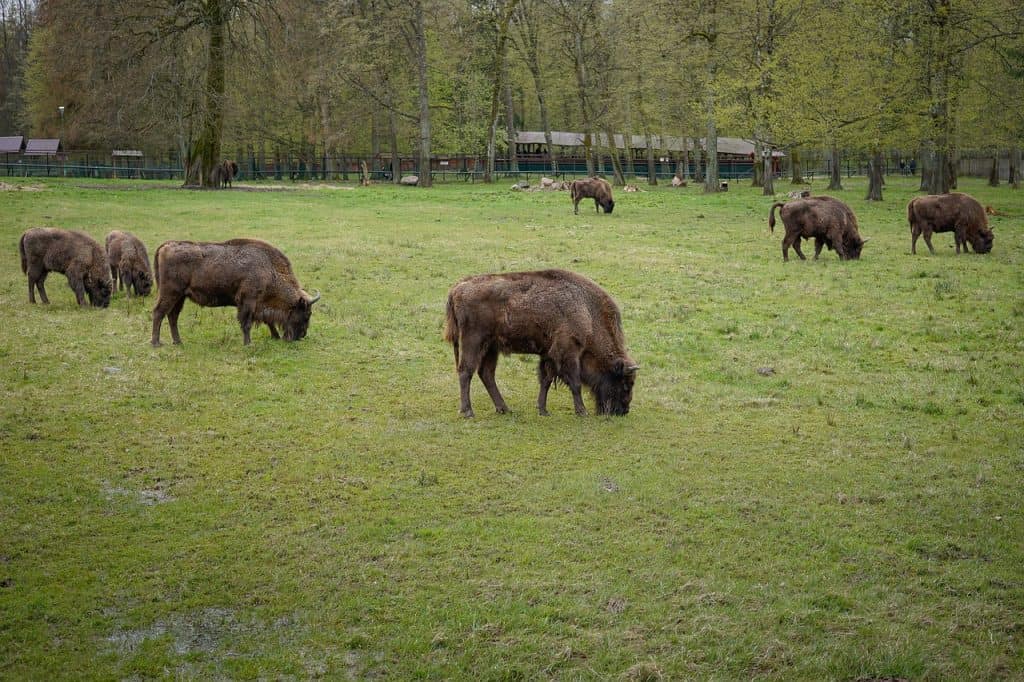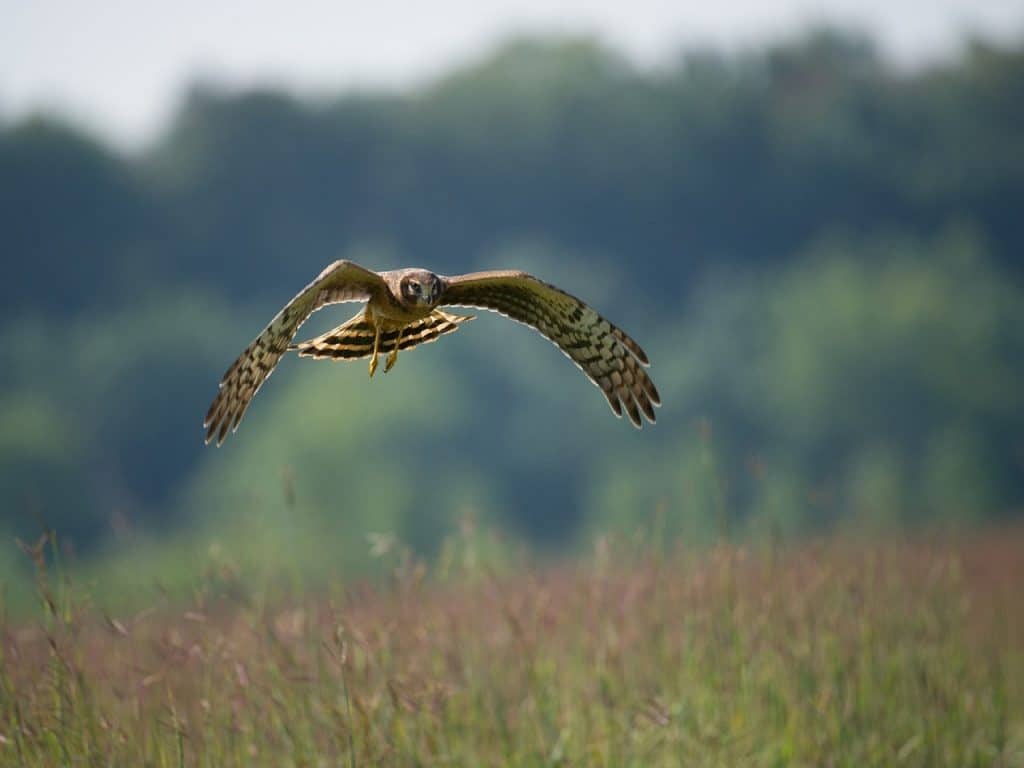Kozłowiecki Landscape Park was established to protect the Kozłowieckie Forests – the largest forest complex in the vicinity of Lublin near Kozłówka – along with mid-forest meadows, marshes, ponds and agricultural and settlement enclaves.
The area of Kozłowiecki Landscape Park covers the forest complex of Kozłowieckie Lasy and the accompanying mid-forest meadows, swamps and ponds. It is surrounded by agricultural and industrial areas. The park area is flat. The dunes, small moraine hills and river valleys are more distinct accents in the monotonous terrain. The denivelations within the park are up to 50 meters. The highest elevation is the south-eastern part of the park, where the altitudes reach the value of 195-202 m above sea level, to the west the area gently slopes down to 155 m above sea level in the area of ponds in Samoklęska. The largest area of the park is covered by areas with a height of 170 – 180 m above sea level. The water network of the park and its lagging are formed by small rivers: Minina, Krzywa Rzeka, Parysówka, Pracz and the stream from Nasutów. The main river of the park is Minina, which starts in Majdan Krasieniński. It changes its direction several times in places where it collects its tributaries: in Dąbrówka, where the Krzywa River flows out, in Samoklęska, where the Pracz flows out, in Kierzkówka where Minina joins the Parysówka, which is the main river in the northern part of the buffer zone. Ok. 20 km north of the Minina Park, it flows into the Wieprz River – the largest river in the Lublin region.

The compact complex of Kozłowieckie Forests forms one of the largest forest ecosystems in the sparsely forested central and western part of the Lublin Province. Hence, the Kozłowiecki Landscape Park has a typically forest character. Forests cover over 90% of its area. On the other hand, arable lands predominate in the park’s buffer zone: fields, meadows and pastures. There are also fish ponds in the park: the pond in Stary Tartak, Wzory and a small group of Stróżek ponds. In the buffer zone there is also a vast complex of ponds in Samoklęska.
Flora
The stands protected in Kozłowiecki Landscape Park are distinguished by great diversity, both in terms of species composition, as well as age and multi-storey structure. The natural values of the forest have been preserved on large areas. Mixed forests and mixed forests dominate, and on small areas there are dry coniferous forest, wet coniferous forest, swamp forest, alder and riparian forests. Solid oak stands in the “Kozie Góry” reserve and its vicinity, as well as old pine-oak stands, have the greatest natural value. The numerous single sessile oaks growing in the park reach impressive monumental sizes. Sessile oak occurs here on the eastern border of its range.
The undergrowth is also noteworthy, with many rare and protected species, including the white thong, the greenish thorn, the gold-headed lily, the helleborine, the daffodil, the sprout, snowdrop, snowdrop and common ivy. Among other rare species, there are also such mountain plants as: hellebore and aconite.
Rare peat bog and marsh plants are represented by, among others: low birch, common swamp, larch tree, old marsh or European flower. A special ornament of the so-called The “Łąki Dyskie” is a very rare blue polygon. In the meadows we can also find orchids: blood cuckoo, broad-leaved cuckoo and helleborine. The ponds feature water plants such as: white water lily, northern water lily, yellow water lily and duckweed. Occasionally, thermophilic species, such as the sandstone, are also found.

Fauna
The world of animals inhabiting the Kozłowiecki Landscape Park is also rich. The park is a mainstay of forest animals. There are several large ungulates, such as red deer, roe deer, wild boar and elk. Fallow deer brought here in 1962 are a peculiarity and unofficial showpiece of the Kozłowieckie Forests. The representatives of smaller mammals are foxes, badgers and hares. Otters and beavers can be found by the waters.
The most important group of birds are forest species inhabiting mature and old-growth stands. It consists of about 30 species, more than half of which are hollow trees; Among them, the perennial flycatcher and the white-necked flycatcher, middle and black woodpecker, some species of tit, forest treecreeper and nuthatch stand out. There is also a large group of birds associated with the aquatic environment. At the ponds, we can meet a little grebe, a red-necked grebes and a two-tailed grebe, an temple, a bittern, a little bittern, an aquarius, a gray heron, a tufted duck, a brown cap, a mute swan and a marsh harrier. On the other hand, meadows and mid-forest clearings are the place of woodcock, magpie or lapwing.
The representatives of reptiles in the park are: sand lizards, viviparous and slowworm, snakes: grass snake and viper, and the only Polish species of turtle: pond turtle.
In the vicinity of ponds, oxbow lakes, peat ponds and ponds, the breeding sites and living places of amphibians are concentrated: the common toad, the fire-bellied toad and the common toad. The tree frog can be found in mid-meadow and aquatic tree stands.
On the other hand, meadows, especially those in the valleys of the Minina, Krzywa River and upper Parysówka, are rich feeding grounds for many species of butterflies and bumblebees.
Tourism
Landscape parks are areas especially predisposed to fulfill tourist and recreational functions. There are no prohibitions to move outside the trails and designated routes or to collect undergrowth.

Kozłowiecki Landscape Park allows for walking, cycling, cross-country skiing, mushroom picking or running training. Wzory ponds are a popular fishing spot.
Interesting tourist infrastructure in the Kozłowiecki Landscape Park has been prepared for visitors by the Lubartów Forest District.
The Kozłowieckie Forests complex is surrounded by a network of forest car parks and parking spaces. Forest roads running through the Kozłowieckie Forests complex are excluded from car traffic (except for emergency vehicles), which makes them safe for cyclists. A network of bicycle routes has been marked along them. The starting point is the forest car park next to the forester’s lodge in Kopanin. There are two loops to choose from, the shorter one with a length of 11.7 km, or the longer one with a length of 23 km. A cross-country trail has been prepared for runners, which also starts at the parking lot in Kopanin. Two variants are also available here, the shorter one is 11.7 km and the longer one is 23 km.
It is true that the only marked hiking trail runs along a fragment of the buffer zone, but you can successfully wander through the park using the network of forest roads and a comma.
In Kopanin and in the Old Sawmill, comfortable rest areas equipped with shelters, tables, benches, educational boards and toilets are prepared. There is also a playground and a bonfire site in Kopanin, and a health path in Stary Tartak.
An interesting place is the ecological village of Dąbrówka in the western part of the park. There is a Mini ZOO waiting for tourists, a shop with ecological products, there are regular events and workshops such as drumming, handicrafts and others.
The photos and content come from the Kozłowiecki Landscape Park website


